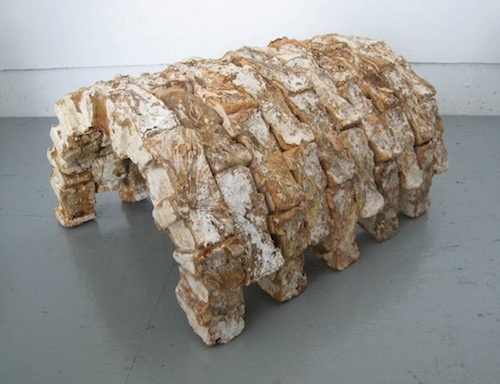Selections from the Design and Violence website. Phil Ross (American, b.1966). Design Engineer: Michael Sgambellone (American, b. 1966). Department of Art and Architecture (est. 1969), The University of San Francisco (USA, est. 1855). Far West Fungi, Monterey, California (Est. 1997). Mycotecture, 2009. Ganoderma lucidum fungus, chopsticks, and glue, 28 x 48 x 60" (50.8 x 121.9 x 152.4 cm). Image courtesy of the designer. Video editing by Marcella Faustini.
Paola Antonelli, December 18, 2014
Creating exhibitions is definitely not a linear process. I think there's organization in my process, but it doesn't really show. I'll have a list of ideas for exhibitions that I keep in my Dropbox with me all the time, and I add to it. Then, I pinboard different bookmarks and keywords. I keep exhibition ideas and sketches in there.
The themes I'm interested in right now, which will hopefully become exhibitions, have to do with the world. I'm very interested in sustainability. Books like Elizabeth Kolbert's, The Sixth Extinction, lead me to seriously take into account both the now and the long-term. I'm very interested in politics, sociology, and technology. These are themes that are usually not immediately translatable into an art museum exhibition, a curator has to mediate them.
How does one make an exhibition out of the concept of The Sixth Extinction and the fact that we are seriously screwing up our planet? Putting posters and manifests those on the wall doesn't work, not in an art museum. I start by looking for design, objects and concepts that enable me to make that point. Then, the designers and the artists that I meet inform what I'm doing. So, progressively I shape the idea, and it becomes clearer and clearer.
I always have several projects going at the same time. Because of the museum's schedule, or something that happens in the world, or because a designer particularly inspires me, one of these ideas forces me to just jump into motion.
The Design and Violence project is a good example. It's online. It's a very simple WordPress site. Why? Because I didn't want to wait. I had this idea that came when I first read about the 3D printed gun, about two years ago. I remember that my jaw dropped. My jaw dropped because I realized how naïve I had been until that moment. I had kept on thinking that, "Oh, designers take a Hippocratic oath." Or, "Oh, designing is good. Technology is good." And then here, all of a sudden, open source was used for deviant purposes and 3D printing enabled people to make guns at home.
Around the same time, Steven Pinker, renowned cognitive scientist and psychologist, published a book called, The Better Angels of our Nature, which argues that our society is becoming less violent. Pinker is a serious scholar and his argument is based on data. However I kept on thinking that I could not believe it, that something didn't compute. So, I started thinking that maybe one thing that I could do was to try and explore the manifestations of violence in contemporary society using design objects.
I thought about it as a show, but it would have taken many years before the gallery that I wanted could be available. So, my co-curator, Jamer Hunt and I decided to do a website. That would have also enabled a real conversation with our audience.
We launched the website in October 2013. Every week, we publish a different object and ask a different writer to comment on the object. The writers are amazing and have included Steven Pinker, William Gibson, and Anne-Marie Slaughter. We've also had the High Commissioner for Refugees of the United Nations, Nobel Prize winners, and recently, even Judge Shira Scheindlin, she who declared stop-and-frisk police tactics unconstitutional. She commented on the plastic handcuffs that many police departments use, along with bite/spit masks.
At the end of each piece, we ask a question. Sometimes we get an amazing debate with the audience. Overall, I consider this a curatorial experiment. It's not a physical exhibition, but sometimes we're too tethered to physical shows. Some ideas just can't wait.
There are other ideas - I mean, no idea can really wait - but there are ideas that maybe one can be more patient about. I work on those, too. But really, ideas that become urgent inform which projects become active.
Paola Antonelli is the Senior Curator of Architecture & Design and the Director of R&D at MoMA.

